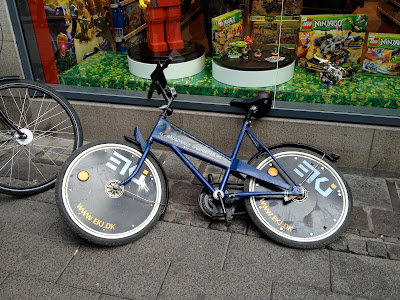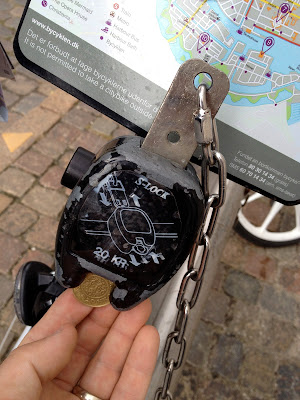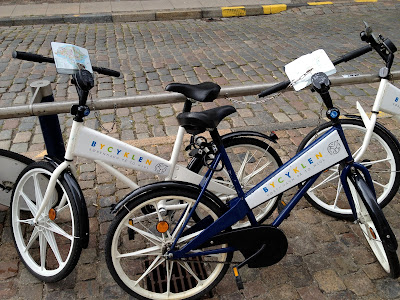 |
| bike slot #18 at a bike station. you can see the two access points that lock the bike front basket frame into the bike stand to secure the bike. red light indicates that the bike is locked. after swiping the card this little light turns green and the bike is unlocked and can be picked up off the stand. |
the Copenhagen bike share has been on my list of "things to see" long before I knew I was coming to Sweden/ Malmo/ Scandanavia/ Denmark. the Copenhagen bike share, started in 1995, was successful many years before Paris, Barcelona, and even Boston jumped into the fray. though it was not the first bike share program in the world, it was the first large scale, "free" city system that had unique bikes (parts could not be easily interchanged with other bikes). unlimited bike use for a small deposit, bike stands throughout the downtown area, and a strict boundary of where the bikes could be used (police fine bike users if caught outside downtown city limits) factored into making the system a huge success.
 |
| Copenhagen bike share bike lying in the street. maybe the borrower of this bike went into the lego store? |
I couldn't wait to try it out when Devo (visiting for a long weekend from Paris) and I hopped the train to Copenhagen. in fact, we went directly to the tourist info location near Tivoli and the Central Train Station to get a map and break down some bills to the 20 kroner coins that one needs to unlock the bikes.
 |
| key that keeps bike locked. to release the key the user inserts one 20 kroner coin. once the coin has been inserted, the key pops out and the bike is free to roll. upon returning the bike, the user inserts the key and the 20 kroner coin pops out and the key holds the bike locked. |
we should have known from the start that getting onto the bikes would be easier said than done. when talking to the woman at the tourist center we were handed our first clue of what was to come. "good luck finding one," she said when we asked about the bike share, "you're better off renting a bike." undeterred we bought a
Danish (yes, this is where they come from) to create two of the necessary 20 kroner coins to unlock the two bikes.
 |
| bike share bike rack in popular square in Copenhagen. all of the bike share bikes are gone and regular bikes are locked in their place. you can see the chain with the key at the end dangling down to the cobblestones. |
as we walked through the city, we realized that the bike share locations are nothing more than simple nondescript metal racks that look pretty much like any other. one of the reasons that we had trouble finding them is that there are no signs, every one we found was devoid of bike share bikes and instead were surrounded by normal bikes locked where the share bikes would have been.
 |
| Copenhagen bike share bike locked via chain to the rack. each bike comes with a map showing the boundary inside which the bike must be kept (or the user is fined by police). notice the (incorrect) silver coin sticking out where the 20 kroner coin should be inserted to release the bike. this bike cannot be freed from the rack due to the improper coin blocking the path for the correct coin to release the key. |
we gave up the search for bikes because we were having no luck, but continued walking the city and enjoying the pedestrian streets, amazing people watching, monuments and beautiful buildings, and general scene (the neighborhood was very crowded with everyone from locals to tourists to street performers). we wandered, checking out the amazing surroundings and enjoying the freedom of the Copenhagen city streets.
 |
| inserting 20 dkk into the locking mechanism to release the key (top) that frees the bike to be ridden. the chain in the picture connects the key to the bike rack and dangles freely once the bike is released. |
of course as soon as we gave up looking for a bike rack with share bikes on it, we found one. five bikes locked up on one single rack off the beaten path from the busiest pedestrian street, near the state house, stock exchange, and one of the main canals downtown. jackpot.
 |
| five bike share bikes all locked to the rack on a street near downtown. jackpot. or maybe not... |
again it should have been obvious that it was too good to be true. two of the five bikes were locked together by a personal lock which basically means the bikes were no longer shareable and could only be used by the j#*ks (jerks) who decided that sharing is not caring. so those two were out. the next bike opened up successfully by sliding the
20 kroner coin into the slot and releasing the key and freeing the bike. but (sad face) the last two bikes had been jammed with the wrong size coins and these coins were stuck, preventing either removing the existing coin or freeing the key and taking the bike.
 |
| after adding the correct 20 dkk coin, the key releases, freeing the bike |
the lesson here to me is that the free bike share system with a low entry fee (20 Danish kroner is less than $4 American) allows for the user group to not respect or take responsibility for the bike and the system itself. I agree with the low entry fee and support the idea that everyone can use the bike(s), but the result is that most available bikes are either being improperly used or are in use and not available.
 |
| once the key is reinserted, the coin pops free from the bottom |
one could argue that the
Boston share program (called Hubway) has its own problems, but the system works effectively and does not have the same problems as the Copenhagen one. the Boston system, like many newer ones across the globe, requires a credit card to borrow a bike. this makes the system no longer anonymous. in addition to the credit card identifier making each borrower accountable, each bike is "checked in" when returned to the rack via a click digital connection point, ensuring that bikes are returned and also allowed for the system to know where all bikes are located. this check in system allows a simple iphone app to tell users where there are bikes to pick up and where there are empty spaces to return the bike.
 |
| two Copenhagen bike share bikes locked together with personal lock, making them inaccessible to regular people |
the Boston system just completed it's first full year to rave reviews and membership was, for the first year, above predictions. hopefully it will continue to be a success and build upon what has come before it, including the Copenhagen bike share, one of the first of its kind anywhere on the globe in 1995.
for more info on:





















